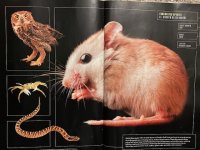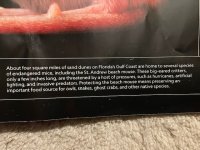Martin Nowak
Active member
Gist of the story: five endangered animals and the animals which have a natural history life relationship with the named animal.
Example is the St. Andrew Beach Mouse.
The author explains this beach mouse needs protection as it is a food source for other animals.
She indicates a snake that depends on the mouse for sustenance is the Eastern Hognose Snake, with a picture of the snake. The range of the mouse is only 4 square miles. (see captions on the pictures)
My experiences observing herptiles on beach front sand dunes in Alabama and portions of the Florida panhandle, includes seeing gray rat snakes, corn snakes, king snakes, pygmy rattlesnakes, coachwhips, and EDBs. Admittedly, my singular observation experiences do not create certainty, nor absolute facts in the range of the mouse. I’ve just never seen an Eastern Hognose in those beachfront dunes or dead in beachfront hotel parking lots. My general experiences with Eastern Hognose Snakes would not support their diet being mouse dominant or even sufficient to be the life determinant for the species' population. Reader’s comments and experiences with this topic and article assertions about Eastern Hognose ?
Other credible sources describe animals cohabiting with this beach mouse. None describe co-dependency such as being a food source. The only snake I could find mentioned is the coachwhip; which does frequent beachfront sand dunes. Certainly, rat snakes, king snakes, coachwhip, rattlesnakes, would eat the mouse upon opportunity.
The issue I have with the NatGeo story is that credible literature clearly indicates primary threats to the mouse are construction and house cats. Along with fox and coyote. Yet the author ignores these specific issues. She “weaves in” the Eastern Hognose Snake as a predator needing the endangered mouse as food. Very few authors of stories in this lane will openly castigate house cats and feral house cats. Protecting the mouse is fine - using such protection to assert having a food source for hognose snakes seems a stretch. Readers?
Endangered Beach Mouse
National Geographic. January 2024 issue. Pages 114-115
Author: Natasha Daly https://www.natashaldaly.com/about
Photographer: Joel Sartore https://www.joelsartore.com/
As this magazine is by subscription, pictures of the two pages are attached.
Readers may access the story for free in exchange for their email address.
https://www.nationalgeographic.com/animals/article/endangered-species-act-photo-ark-animals
Example is the St. Andrew Beach Mouse.
The author explains this beach mouse needs protection as it is a food source for other animals.
She indicates a snake that depends on the mouse for sustenance is the Eastern Hognose Snake, with a picture of the snake. The range of the mouse is only 4 square miles. (see captions on the pictures)
My experiences observing herptiles on beach front sand dunes in Alabama and portions of the Florida panhandle, includes seeing gray rat snakes, corn snakes, king snakes, pygmy rattlesnakes, coachwhips, and EDBs. Admittedly, my singular observation experiences do not create certainty, nor absolute facts in the range of the mouse. I’ve just never seen an Eastern Hognose in those beachfront dunes or dead in beachfront hotel parking lots. My general experiences with Eastern Hognose Snakes would not support their diet being mouse dominant or even sufficient to be the life determinant for the species' population. Reader’s comments and experiences with this topic and article assertions about Eastern Hognose ?
Other credible sources describe animals cohabiting with this beach mouse. None describe co-dependency such as being a food source. The only snake I could find mentioned is the coachwhip; which does frequent beachfront sand dunes. Certainly, rat snakes, king snakes, coachwhip, rattlesnakes, would eat the mouse upon opportunity.
The issue I have with the NatGeo story is that credible literature clearly indicates primary threats to the mouse are construction and house cats. Along with fox and coyote. Yet the author ignores these specific issues. She “weaves in” the Eastern Hognose Snake as a predator needing the endangered mouse as food. Very few authors of stories in this lane will openly castigate house cats and feral house cats. Protecting the mouse is fine - using such protection to assert having a food source for hognose snakes seems a stretch. Readers?
Endangered Beach Mouse
National Geographic. January 2024 issue. Pages 114-115
Author: Natasha Daly https://www.natashaldaly.com/about
Photographer: Joel Sartore https://www.joelsartore.com/
As this magazine is by subscription, pictures of the two pages are attached.
Readers may access the story for free in exchange for their email address.
https://www.nationalgeographic.com/animals/article/endangered-species-act-photo-ark-animals



